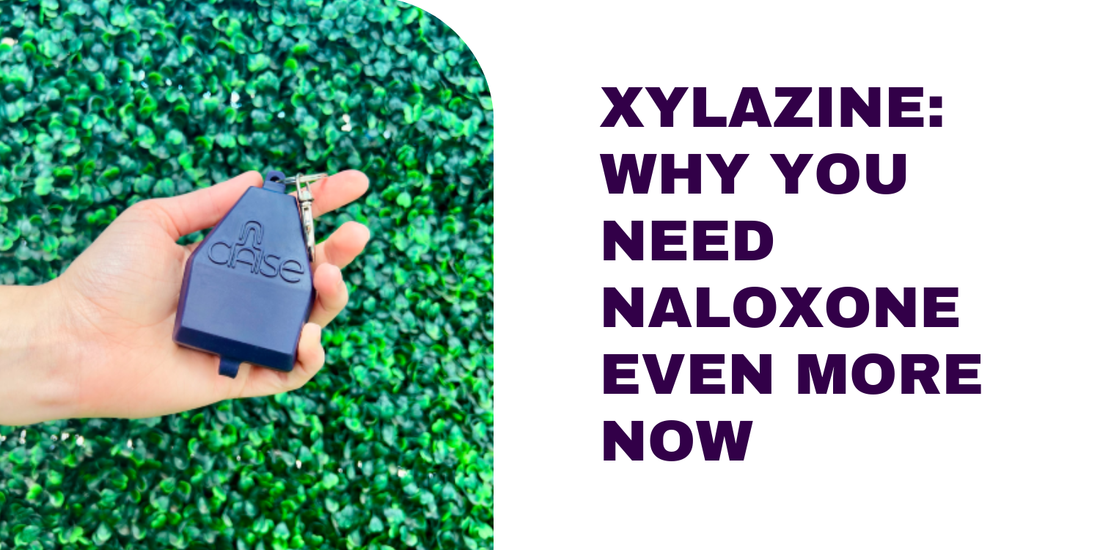
The Rise of Xylazine: Why You Need Naloxone Even More Now
Share
Understanding the New Overdose Threat
The landscape of the opioid crisis is evolving, and xylazine—a powerful veterinary sedative—has emerged as a dangerous new addition to the illicit drug supply. Often mixed with fentanyl and other opioids, xylazine complicates overdoses, making them more difficult to reverse. While naloxone remains the gold standard for reversing opioid overdoses, its role has become even more critical in combating xylazine-related overdoses.
The alarming rise of xylazine in fentanyl-laced drugs has led to increased fatalities, prolonged sedation, and severe health complications. Understanding what xylazine is, how it interacts with opioids, and why naloxone is still essential can help save lives in an increasingly dangerous drug landscape.
What Is Xylazine?
Xylazine is a non-opioid sedative used by veterinarians to tranquilize large animals such as horses and cattle. However, in recent years, it has been found in illicit fentanyl and heroin supplies, increasing the risk of fatal overdoses. Xylazine, also known as “tranq” or “zombie drug,” is particularly dangerous because:
● It prolongs sedation far beyond what opioids typically do, leaving individuals unconscious for hours.
● It does not respond to naloxone, meaning standard opioid overdose treatment may not fully revive an affected individual.
● It causes severe skin wounds and necrosis, sometimes requiring amputation.
Why Is Xylazine Being Added to Fentanyl?
Drug suppliers mix xylazine with fentanyl to extend its effects, making the high last longer. Because it is not an opioid, xylazine does not respond to naloxone, making overdose reversal more complicated.
According to recent reports:
● Nearly 90% of fentanyl samples in Philadelphia contained xylazine in 2023.
● Xylazine-positive overdose deaths increased by 276% between 2019 and 2022 in the U.S.
● The drug is spreading rapidly, with rising detections across New York, Chicago, and the Midwest.
Why Naloxone Is Still Essential
Despite the presence of xylazine, naloxone remains the most important first-line defense against overdoses. While naloxone does not reverse xylazine’s effects, it still plays a critical role in keeping overdose victims alive.
Over 90% of Overdose Deaths Still Involve Opioids
Even when xylazine is present, most overdoses are still driven by opioid-related respiratory depression. Naloxone rapidly restores breathing, preventing opioid-induced fatality.
Xylazine May Prolong Sedation, But Naloxone Restores Breathing
Xylazine may cause deep sedation, but fentanyl remains the primary respiratory depressant. Administering naloxone revives breathing, buying critical time for emergency responders to provide additional care.
Naloxone Can Prevent Brain Damage from Oxygen Deprivation
Xylazine-induced overdoses often leave victims unconscious for extended periods. If someone is not breathing properly, naloxone can restore oxygen flow, preventing severe brain damage or death.
How to Respond to Xylazine-Related Overdoses
Overdose response protocols must now account for the presence of xylazine in the drug supply. Since naloxone alone will not fully revive someone exposed to xylazine, additional interventions are required.
Administer Naloxone – It Still Reverses the Opioid Component
● If you suspect an overdose, immediately administer naloxone.
● If there is no response within two to three minutes, give a second dose.
● Continue administering additional doses as needed until emergency responders arrive.
Provide Rescue Breathing – Xylazine Can Suppress Breathing Beyond What Naloxone Can Reverse
● Unlike opioids, xylazine does not cause respiratory depression in the same way, but it can increase sedation to dangerous levels.
● If the person is not breathing, provide rescue breaths every five seconds.
● Use a CPR face shield to protect yourself while assisting.
Seek Immediate Medical Help – Medical Intervention is Required for Complete Recovery
● Even if the person revives after naloxone, xylazine sedation may persist for hours.
● Overdoses involving xylazine require advanced medical care, including oxygen support and IV fluids.
● Call 911 and stay with the individual until help arrives.
How to Stay Prepared for Xylazine Overdoses
Carry Multiple Doses of Naloxone
Since xylazine-containing fentanyl often requires multiple doses of naloxone, always carry more than one dose. Keeping naloxone in a naloxone keychain case or tactical naloxone nasal spray holder ensures it is protected and accessible in an emergency.
Learn Rescue Breathing Techniques
Because xylazine increases the risk of long-term sedation, providing rescue breathing alongside naloxone is crucial. Many harm reduction organizations offer free overdose response training, including CPR and rescue breathing demonstrations.
Recognize Xylazine-Specific Symptoms
While opioid overdoses typically cause slow breathing and pinpoint pupils, xylazine-related overdoses may involve:
● Unusual, deep sedation lasting hours
● Non-responsiveness even after naloxone revival
● Severe skin wounds and ulcerations
● Recognizing these signs can help responders adjust care appropriately.
Why Public Access Naloxone Cases Matter More Than Ever
With xylazine overdoses rising, it is critical to increase naloxone accessibility. Businesses, schools, and public spaces should install indoor public access Narcan cases, just like AED stations.
● Airports, hotels, and transit hubs are high-risk areas where overdoses occur.
● Workplaces and community centers can protect employees and visitors with emergency naloxone access.
● Colleges and universities are beginning to install naloxone stations to address student overdoses.
Expanding naloxone access in public and private spaces is one of the most effective ways to reduce preventable overdose deaths.
Final Thoughts: Staying Ahead of a Changing Crisis
The presence of xylazine in the opioid supply has made overdose response more challenging, but naloxone remains the most powerful life-saving tool available.
Key Takeaways:
● Naloxone still reverses the opioid portion of overdoses, even when xylazine is present.
● Xylazine increases sedation, meaning rescue breathing is often necessary.
● Medical intervention is required for full recovery—always call 911.
● Carrying naloxone and knowing proper response techniques can save lives.
As xylazine continues to spread, education and preparedness are critical. The more people who carry naloxone and understand how to respond, the more lives will be saved.
Get your naloxone kit today and stay prepared for the evolving overdose crisis.


